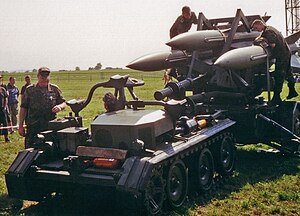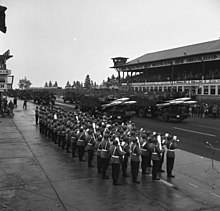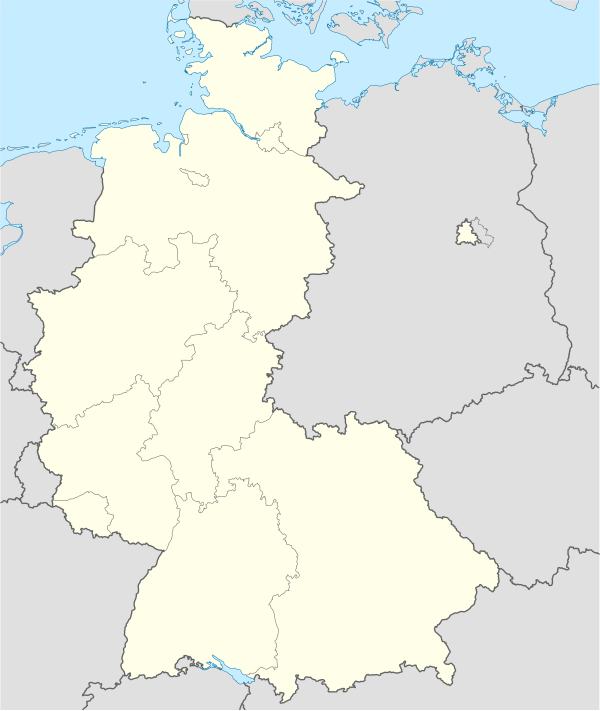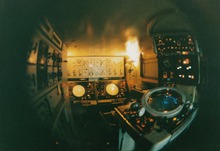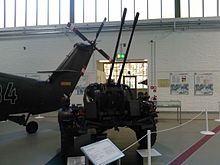MIM-23 HAWK
| Manufacturing company | Raytheon (USA) |
| drive | Solid rocket engine |
| length | 5.08 m |
| diameter | 0.37 m |
| span | 1.19 m |
| Operating weight | 584 kg |
| Operational range | 25 km |
| Bet Peak | 13,700 m |
| Maximum speed | 800 m / s (Mach 2.4+) |
| Operating crew | 2 officers, 49 NCOs and men |
| Steering method | semi-active homing guidance method |
| Warhead | 54 kg fragmentation warhead |
| Deployment procedure | Operator-guided or semi-automatic with support from a weapon computer |
| Combat Charge | up to 40 guided missiles per fire unit |
| Rate of fire | maximum 1 LFK every three seconds |
| Introduction: | 1962 (US Army); 1965 German Air Force |

MIM-23 HAWK is a mobile all-weather anti - aircraft missile system made in the USA . The manufacturer was Raytheon . The system entered service with the US Army in 1959/1960 during the Cold War . To date, HAWK has been sold in different configurations to 25 countries around the world.
Alongside the more extensive Nike system and its successor, the MIM-104 Patriot, the weapon system formed the backbone of NATO's integrated air defense for several decades and is still in use in some NATO countries. The "Basic-HAWK" version was introduced to the German Air Force in 1965 . After several modernizations and restructurings, it was decommissioned in 2005 after 40 years.
history
In order to adapt the German air defense to the changed threat situation that arose with the introduction of supersonic jet aircraft , it was decided at the beginning of the 1960s to equip the Bundeswehr with anti-aircraft missile systems manufactured by the United States. They should replace the now clearly overburdened anti-aircraft tube artillery . The Nike Ajax heavy anti-aircraft missile system (later converted to Nike Hercules ) was chosen for combating high-flying targets (mainly bombers ). The HAWK system was supposed to take over the fight against flight targets at low and medium altitudes (especially fighter bombers ).
description
HAWK is a medium-range anti-aircraft missile system for use against flight targets in the low to medium altitude range, which can be fully deployed through loading on single-axle trailers as well as on trucks. All radar devices, the situation and evaluation center (Information Coordination Center, ICC), the fire control center (Platoon Command Post, PCP) and the fire control center (Battery Control Central, BCC), launch devices (Launcher, LCHR), rocket pallets as well as the command cabins and the 56 kVA power generating sets (SEA or GEN) and all technical accessories were dismantled within half an hour and on the march.
The destination search is undertaken by one pulse (Pulse radar acquisition, PAR) and a continuous-wave radar detection (Continuous Wave Radar Acquisition, CWAR). To combat it, the flight target is illuminated with another continuous wave radar (high-power illuminator radar, HPIR). The reflected radar energy is used by the missile's steering unit to guide the target, with additional direct control signals being sent which are received by an antenna at the rear of the missile. This principle is called semi-active homing guidance . The name of the weapon system is based on this procedure (HAWK, homing all-the-way killer). The warhead was ignited by comparing the signal strength of the radar energy of the HPIR received from a side antenna and a rear antenna. If the missile was level with the target, the signal from the side antenna (the radar energy reflected from the target) became weaker and the ignition was triggered.
For the correct distance measurement of a flight target even under electronic interference measures, a range-only radar (ROR) was also used, which could be operated continuously over a very large frequency range and was therefore practically non-disruptive. PCP and ICC were also equipped with the NATO-wide electronic friend-foe recognition (Identification Friend / Foe, Selective Identification Feature: IFF / SIF) and the central computer (Automatic Data Processor, ADP). The latter had a working memory of 64 kB based on ring core technology, which retained the data last saved even when the operating voltage was switched off or the operating voltage failed.
The missile has an effective combat range of a maximum of 25 kilometers at a maximum altitude of just under 14,000 meters. The acceleration of the solid fuel drive was sufficient to reach the simple speed of sound (Mach 1) a few meters after leaving the starter device.
In the full-relay configuration with two start groups, two flight targets could be fought at the same time, both HPIRs were operated at the BCC and the PCP was available as a reserve device.
The simultaneous use of BCC and PCP with one start group each resulted in a significant tactical advantage: One half-relay (Battery Minus) was able to lead the fire fight, while the other half-relay (Assault Firing Unit) relocated under the protection of the active half-relay. This process was called the "rollover effort".
The half-relay configuration (Assault Firing Unit, AFU) that was common in the German Air Force from the end of the 1990s had only one start group and could only carry out one target fight before the next target could be fought. A last improvement, introduced in the early 1990s, was an electro-optical camera (HEOS) with an extreme zoom lens , which was installed on both HPIRs and, under good visibility conditions, allowed purely optical target tracking up to a distance of 15 km.
Use in the Bundeswehr
Introduction and modernization
In the Bundeswehr , HAWK was introduced to the Luftwaffe from 1963 , initially in the Basic-HAWK version . In the mid-1970s, the upgrade to Improved HAWK (IHAWK) resulted in a significant increase in combat value. Among other things, by increasing the radar performance, target detection and combat became more reliable, and the introduction of a digital weapon system computer made it possible to improve operating procedures. With the PIP (Product Improvement Program) and PIP-II versions , the switch to semiconductor technology and digital technology was continued in the mid to late 1980s, thereby significantly increasing operational reliability.
The Cold War
At the height of the Cold War , 36 systems (batteries, later squadrons) were used in nine anti-aircraft missile battalions (later squadrons and groups) of the German Air Force. In the NATO alliance together with Dutch, Belgian and US-American units, these HAWK units formed the so-called HAWK belt, which stretched from the Danish border across Germany to the border with Austria. The individual positions within the HAWK belt were chosen in such a way that the effective areas of the individual fire units overlapped, even if individual weapon systems failed, thus guaranteeing complete coverage. In addition to the peace positions, several deployment positions (KILO, LIMA and MIKE patterns) were explored per battery / squadron, into which the weapon system would have been relocated in the event of an emergency. In the NATO alliance, the HAWK units had the task of ensuring the air defense of Central Europe around the clock. For this purpose, all anti-aircraft missile units were already subordinate to NATO in peacetime (“assigned”). Numerous radar command posts and command posts ensured the command of the individual anti-aircraft units in peacetime and in times of crisis.
The HAWK belt:
| nation | Unit / association | Location | barracks | BOC | Positions | Duration |
|---|---|---|---|---|---|---|
| Germany | FlaRakBtl 39 | Eckernförde | Preusser barracks | BOC 66 Waabs | Maasholm (location) , Waabs (location) , Sehestedt (location) , Tolk (location) | 1973-1989 |
| Germany | FlaRakBtl 38 | pagan | Wulf Isebrand barracks | BOC 65 Dellstedt | Hude (location) , Dellstedt (location) , Deichhausen (location) , Windbergen (location) | 1967-1989 |
| Germany | FlaRakBtl 37 | Cuxhaven - Altenwalde | Hinrich-Wilhelm-Kopf barracks | BOC 64 Belum | Belum (location) , Lamstedt (location) , Krempel (location) , Gudendorf (location) | 1974-1989 |
| Germany | FlaRakBtl 36 | Bremervörde | Vörde barracks | BOC 63 Deinstedt | Ebersdorf (location) , Deinstedt (location) , Vollersode (location) , Bramel (location) | 1972-1989 |
| Germany | FlaRakBtl 31 | Westertimke | Timke Barracks | BOC 62 Nartum | Nartum (location) , Eversen (location) , Oyten (location) , Westerbeck (location) | 1963-1989 |
| Germany | FlaRakBtl 35 | Delmenhorst | Caspari barracks | BOC 61 Wachendorf | Wachendorf (location) , Wittlohe (location) , Lichtenmoor (location) , Wohlenhusen (location) | 1968-1989 |
| Netherlands | 5 GGW | Stolzenau | Barracks Stolzenau | BOC 60 Stolzenau | Borstel , Winzlar , Hoysinghausen , Reinsdorf | 1964-1988 |
| Netherlands | 4 GGW | Hessian Oldendorf | Hessisch Oldendorf Air Station | BOC 59 Hessisch Oldendorf | Barsinghausen , Bad Münder , Goldbeck , Reinsdorf | 1964-1975 |
| Netherlands | 3 GGW | Blomberg | Klüter barracks / Nederland Kazerne | BOC 58 Blomberg | Laatzen , Horn-Bad Meinberg (Velmerstot), Goldbeck , Schwalenberg | 1964-1975 |
| Belgium | 43 A | Brakel | Maenhoudt Kazerne | BOC 57 Rheder | Tietelsen , Bosseborn , Willebadessen , Bad Driburg | 1966-1995 |
| Belgium | 62 A | Essentho | Caserne Jonet | BOC 56 Essentho | Rhoden-Quast , Oesdorf , Flechtdorf , Freienhagen | 1968-1995 |
| United States | Bad Hersfeld | McPheeters Barracks | BOC 55 Bad Hersfeld | Rothwesten , Bad Hersfeld , Rainrod , Homberg (Ohm) | 1964-1970 | |
| United States | 1-1 ADA | Butzbach | Castle barracks | BOC 54 Butzbach | Bad Kissingen , Wildflecken , Finkenberg , Ottrau , Semmelberg | 1984 conversion to Patriot |
| United States | 2-2 ADA | to water | Rivers Barracks | BOC 53 casting | Giessen, Ockstadt , Aschaffenburg , Mainbullau | 1984 conversion to Patriot |
| United States | 3-59 ADA | Hanau | Air base | BOC 51 Hanau Air Base | Hanau Air Base , Friedberg (Ray Barracks), Kirchgöns , Babenhausen , Wildflecken | HAWK-Improved |
| United States | 3-7 ADA | Schweinfurt | Ledward Barracks | BOC 50 Schweinfurt | Schweinfurt ( Conn Barracks ), Schweinfurt (Ledward Barracks), Bamberg (Warner Barracks), Dörrnwasserlos , Sulzheim , Bad Kissingen | 1984 conversion to Patriot |
| United States | 6-52 ADA | Wurzburg | Emery Barracks | BOC 49 Würzburg | Würzburg (Emery Barracks), Kitzingen , Giebelstadt , Wertheim , Bad Mergentheim | |
| United States | 2-57 ADA | Ansbach | Barton Barracks | BOC 48 Ansbach | Ansbach (Barton Barracks), Illesheim , Katterbach , Oberdachstetten , Reinwarzhofen | HAWK-Improved |
| United States | 3-60 ADA | Grafenwohr | Grafenwoehr Training Area | BOC 45 Grafenwoehr | Grafenwoehr, Hohenfels , Amberg , Oberhinkofen | |
| Germany | FlaRakBtl 34 | Rottenburg an der Laaber | Colonel General Wise Barracks | BOC 44 tube | Leibersdorf (location) , Rohr (location) , Freinhausen (location) , Wettstetten (location) | 1969-1989 |
| Germany | FlaRakBtl 32 | Freising | General-von-Stein-Kaserne | BOC 43 Erding | Schweinersdorf (location) , Giggenhausen (location) , Haindlfing (location) , Erding (location) | 1964-1989 |
| United States | Freising | Vimy barracks | BOC 42 Freising | Erding , Freising , Oberschleißheim | 1961-1965 | |
| France | 402e RA | Dachau | Eastman Barracks | BOC 42 Dachau | Erding , Oberschleißheim , Wettstetten | 1965-1966 |
| France | 402e RA | Murnau | Kimbro Barracks | BOC 41 Murnau | Murnau | 1965-1966 |
| Germany | FlaRakBtl 33 | Lenggries | Prince Heinrich Barracks | BOC 41 small hard penning | Kleinhartpenning (location) , Deining (location) , Lampferding (location) , Kirchdorf (location) | 1973-1989 |
Property protection of the aircraft carrier Rhineland-Palatinate :
| nation | Unit / association | Location | barracks | BOC | Positions | Duration |
|---|---|---|---|---|---|---|
| United States | 2-62 ADA | Spangdahlem | Spangdahlem Air Base | BOC 16 Spangdahlem | Balesfeld , Welschbillig (Butzweiler), Hisel , Reitscheid | HAWK-Improved |
| United States | 6-62 ADA | New bridge | Army Hospital Neubrücke | BOC 20 new bridge | Schönborn (Rockenhausen), Wüschheim , Baumholder , Hontheim | HAWK-Improved |
| ||||||||||||||||||||||||||
Deployment of the HAWK weapon system in the AFNORTH and AFCENT area |
Reduction and retirement
The system has been continuously modernized during its long service life, although the Bundeswehr has not introduced the last version PIP-III (“Product Improvement Program”). As a result, the systems used by the Luftwaffe remained technically essentially the same as in the early 1980s. Only minor further developments were still integrated, such as the component called HEADTS, which could further process the signals of the CWAR and significantly improved the target acquisition of very slow flying targets such as helicopters.
In the FlaRak network, HAWK, with its now outdated technology and slower data connections, was falling behind the more modern PATRIOT. This came to light in practice, especially when using the integrated HAWK simulation device (Operations Training System; OTS) during training in the so-called “netted scenario”. Overall, there were not only restrictions in combat value in further use - in particular the high operating costs, the increasingly scarce spare parts (especially tube technology) and the extensive personnel, vehicle and maintenance requirements led to the gradual reduction of active units and in the early 2000s Years of retirement. The last two HAWK units of the Bundeswehr were decommissioned at the end of 2005 with the anti-aircraft missile group 15 in Leipheim.
Decommissioned HAWK missiles are partly to Orion - sounding rockets have been upgraded.
The last PCP half-squadron of the Bundeswehr was in Pirmasens until about 2008 and was part of the air combat training facility Polygons , which consists of several positions and various anti-aircraft missile systems from Germany, the USA and the former Soviet Union . Among other things, the 2K12 Kub , 9K33 Osa and the latest Roland -FRR and -FGR (RAD) systems are operated there to enable NATO air force pilots and friendly forces to train under realistic electronic emergency conditions.
Operation of the HAWK system
The HAWK units of the Luftwaffe were fully deployable and designed for all-weather operation. The systems were operated in air defense shift work around the clock from expanded field positions. A shift lasted between 48 and 72 hours and was carried out by one of the three (later four) combat crews. The air defense service was divided into four different levels of readiness, each of which was to be held for a week.
- Readiness levels
- 12 hours released : The devices in the system were subjected to periodic maintenance and inspections. The fire unit was able to assume the next higher status within a period of 12 hours.
- 12 hours : The system was operational in terms of technology and personnel, but was used intensively for training the combat crews on duty; the system was switched off after the end of the training period and after the completion of maintenance work (overnight); the next higher standby status was possible within 12 hours.
- 3 or 6 hours : The devices were continuously connected to the power supply, system and device checks in accordance with regulations were carried out at regular intervals. Unit-internal alarm exercises and reviews by evaluation teams of the association (see section Reviews ) were carried out unannounced. The system was technically and personally ready to take over the highest status without delay.
- 20 minutes : In addition to the conditions listed for the 3 (or 6) hour status, the following requirements apply :
- The fire control center was manned around the clock by at least one operator who was in constant contact with the superordinate command post of the unit (Battalion Operation Center; BOC) and whose tasks were to monitor the system displays, record alarm messages without delay and alert the operating personnel.
- All radar transmitters were activated or ready to transmit, the weapon system software of the weapon computer was loaded and ready for use, the tactical data link (data link) was synchronized with the system of the higher command post.
- When an alarm message was received (Battle Stations / Blazing Skies), the operator alerted the combat crew by triggering a siren. The subsequent so-called crew drill of the combat crew, which was controlled and monitored by the fire control officer (BCO), ensured by means of defined procedures that the fire unit was technically and personally capable of taking all relevant regulations into account within 20 Minutes to start the fire fight.
- 5 minutes : In the 1960s, instead of the 20 minutes status of the hot battery, a 5-minute standby status was first used, whereby it was necessary for parts of the operating personnel to stay on or in the immediate vicinity of their device, or even at night rest.
- Battle Stations (or Blazing Skies ): Fire fighting stance. At Blazing Skies , for safety reasons, all measures were carried out except for the actual connection of the missiles to the launch devices (each via a connection cable, so-called umbilical).
The four fire units of each HAWK association were in different levels of readiness, so that all four readiness levels were covered by the association during routine operation. This ensured that the air defense mission could be carried out by each association in the assigned sector of the anti-aircraft missile belt. In the event of a breakdown, this also ensured that one of the three other fire units could take over the mission of the association. At the same time, this ensured that the associations were able to react quickly when the alarm levels were raised.
The systems were partially protected against air attacks by concrete shelters or splinter protection walls (revetments) and would have made it possible to fight enemy aircraft in the first hours of a surprise attack. In the event of a crisis or war, however, the units should leave their fixed positions and move to previously explored relocation positions. During the Cold War, this was intensively trained in maneuvers, association and unit exercises and assessed by national and NATO test teams (→ section reviews ). Even during relocations, exercises and maneuvers, the units remained subordinate to NATO and were thus able to carry out their task - fighting enemy aircraft at any time and in any weather condition - without delay. This was possible because the guided missile (LFK) was always carried along with the deployment exercises and the tactical telephone and data connections were set up and operated.
After the end of the Cold War, the strict alarm and shift operating rules were relaxed and day-to-day operations continued. During laying exercises, maneuvers and tactical reviews, only training guided missiles were carried along; the tactical operational aircraft were initially stored in the positioning area. They were later handed over to Air Force depots and stored there for use.
Reviews
ORE
During their shift work, the individual FlaRak units were irregularly checked by test teams from their associations (shooting test and evaluation group or shooting tactical test and evaluation group; SPAG) in so-called ORE ( Operational Readiness Evaluation ; in German: operational readiness reviews) for their tactical / technical readiness for action checked. This took place unannounced at any time of the day or night on arbitrarily selected days, including weekends, public holidays and vacation periods. The technical availability of the system and the level of training of the combat crew were assessed according to tactical guidelines and regulations.
TacEval / OpEval
In tactical reviews by NATO, so-called TacEvals (Tactical Evaluation) and later OpEvals (Operational Evaluation), the following capabilities of the units and associations were regularly assessed by multinational test teams (at intervals of 12 to 18 months):
- Alert phase out of a crisis situation and increase in staff
- simulated fire fighting in different air situations and command situations
- technical readiness for use of the material including the maintenance status of the weapon system and vehicle components
- tactical relocation of the unit and the association, with immediate acceptance of the mission
- Survivability in a ground-based attack
- Survivability during air strikes on the fire unit
- Survivability with foreign use of ABC weapons
- Flexibility and reaction to partial failure of the FlaRak system (improvisation)
- individual and team-related reaction to wounds, fire, sabotage, spying, and the capture of opposing forces
- Implementation of the admission and questioning of opposing prisoners
- individual basic skills of the individual soldier such as handgun shooting, written ABC test, infantry correct behavior
With the alert phase from a crisis situation, the tactical review started regularly on a Monday of the week. The applicable scenario was written for three to four consecutive days of deployment and checked around the clock as part of an exercise.
Annual Service Practice (ASP) and tactical shooting
The units regularly practiced the "sharp shot". For this, the oldest rocket of the unit was brought to the firing range. First the shooting was carried out on the rocket firing range McGregor Range / White Sands Missile Range in the US state of New Mexico, later on the Mediterranean island of Crete on the NATO training area NATO Missile Firing Installation (NAMFI), from which the last German HAWK missile was released in October 2003 started.
In the early years, the annual shooting was carried out as a school shooting, with the units having a starting score of 2000 points. Using drill cards and regulations, the unit was closely monitored during its activities by NATO inspection teams, with deviations and violations being punished by deducting points. The highlight was the start of a single HAWK against a drone. The combat crews carried out the annual shooting without hand weapons and NBC protective equipment.
With the introduction of so-called tactical shooting at the beginning of the 1990s, the units and later the units (as FlaRak groups and squadrons) were evaluated in a tactical environment under simulated combat conditions. All personnel deployed were combat-ready equipped with weapons, NBC equipment and helmets. In the course of the tactical shooting, a scenario based on real conditions was developed, which began with the takeover of the weapon system, a technical check and a combat-like relocation to an assumed operational area. After assuming the commanded operational status, an operation against enemy forces was carried out, in which several HAWK guided missiles were fired at flight targets simulated by drones. After the end of the fighting process, the units had to complete an orderly relocation to a disposition room. Elements from the catalog of demands of the TacEvals and OpEvals were now mainly included in the assessment.
Fire unit
The last fire unit of the HAWK PIP-II version used by the Bundeswehr consisted of the following system components:
Fire control group
- 1 fire control station (PCP; Platoon Command Post) with 1 friend / foe identification device (IFF Siemens 1990 / D21 - Identification Friend / Foe) and the weapon computer (ADP)
- 1 continuous wave acquisition radar (CWAR; AN / MPQ-55 Continuous Wave Acquisition Radar)
Launch group
- 1 continuous wave illumination radar (HPIR; AN / MPQ-57 High-Powered Illuminator Radar) with
- Infrared detection system HEOS (Atlas Elektronik HAWK Electro-Optical Sensor)
- 3 launchers / LCHR (launcher) for 3 guided missiles (LFK) per launcher
- 6 pallet trailers / PAL (Pallet) for the transport of 18 guided missiles (9 LFK as combat load and another 9 as reserve)
- 1 loading vehicle / LDR (loader), (only tracked vehicle of the Air Force)
- 1 Launching Section Control Box / LSCB (Launching Section Control Box)
Power supply
The combat control system / GEHOC (German HAWK Operation Center) was used to conduct combat for a HAWK anti-aircraft missile group (equivalent to a battalion) with up to eight connected fire units (see above ).
Discarded components in the course of the restructuring
Towards the end of the 1990s, the Air Force units were restructured from the BCC full-squadron configuration to a PCP half-squadron (see above). This eliminated the following components:
- Fire control system / BCC (Battery Control Central)
- Location and evaluation center / ICC (Information Coordination Central)
- Pulse Acquisition Radar / PAR (AN / MPQ-50 Pulse Acquisition Radar)
- Distance measuring radar / ROR (AN / MPQ-51 Range Only Radar)
List of user states
Many western-oriented states and allies of the USA used HAWK as an air defense system for their armed forces.
- NATO / Europe: Belgium , Denmark , Germany , France , Greece , Italy , Netherlands , Norway , Romania , Sweden , Spain , Turkey , USA
- Middle East: Egypt , Bahrain , Iran , Israel , Jordan , Kuwait , Saudi Arabia , United Arab Emirates
- Asia: Indonesia , Japan , Singapore , South Korea , Taiwan
The HAWK in action
The first downing of an aircraft by a HAWK took place on June 5, 1967, the first day of the Six Day War . An Israeli hawk shot down a damaged Dassault Ouragan belonging to its own armed forces, which threatened to fall on the nuclear power plant of the Negev Nuclear Research Center . It was also the first HAWK to be fired in a 'live' mission. During the wear war shot Israeli HAWK between eight and twelve Arab aircraft, while the Yom Kippur War were there 12 to 24 for use in this war was the hit probability of the HAWK to more than 50% estimated. During the Iran-Iraq war , a Kuwaiti HAWK shot down an Iranian F-5 . On September 8, 1987, French troops shot down a Libyan Tu-22 bomber in Chad with the help of a HAWK , which was supposed to attack the capital N'Djamena . The manufacturer Raytheon names the number of 40 aircraft shot down by HAWK under war conditions.
In 1986 the Iranian Air Force, with the assistance of Israeli technicians, attempted to fire the HAWK from a Grumman F-14 . The AIM-54 Phoenix's stocks of guided missiles , which were the main armament of the F-14, ran out during the war against Iraq and the US embargo prevented Iran from buying new ones. HAWK and HAWK spare parts, on the other hand, were sufficiently available in the country - among other things because of a secret arms deal with Israel and the US government ( Iran-Contra affair ) - and could also be procured abroad. During the tests it turned out that the data transmission between the AN / AWG-9 fire control system of the F-14 and the HAWK guided weapon did not work properly. Even so, one or two of the sedjil baptized guided missiles were fired in combat. The project was discontinued after the war ended. Many of the missiles produced were converted to air- to- surface missiles by replacing the HAWK warhead with that of an M117 bomb. This weapon got the name Yasser . Photos of the experiments did not reach the West until the end of the nineties, where they gave the impression that they were about the current introduction of airborne HAWKs.
Others
From 1972 to 1992, HAWK fire units of the German armed forces were equipped with a train consisting of four 20 mm twin anti-aircraft guns of the type "Maschinenkanone MK 20 RH 202 Zwilling" from Rheinmetall to protect against low-level aircraft and enemy ground troops .
The abbreviation HAWK is sometimes interpreted as H oming A ll the W ay K iller (English for example: constantly aiming murderer ; see article on the term " homing "). It is possible that the name HAWK first existed (as a so-called " backronym ") and only later did the explanation from the description of the flight behavior of the hawk or the falcon that gave the system its name emerge.
HAWK was jokingly referred to by the German Armed Forces due to its complexity, susceptibility to errors, frequent relocations and shift work as:
- Hope Ajax Will Kill ("Hopefully Ajax will kill / hit")
- Today everything is broken again
- Holiday and Weekend Killer ("holiday and weekend spoilers")
- Pile of work. Little coal
- Go away when it bangs
- Menhir dropping catapult
The OTS simulation device was also jokingly called an officer video game.
A HAWK was used as an upper level in the German space project SHEFEX-I .
Abbreviations
| abbreviation | text |
|---|---|
| A. | Battalion d'Artillerie |
| ADA | Air Defense Artillery |
| AFCENT | Allied Forces Central Europe |
| AFNORTH | Allied Forces Northern Europe |
| ATAF | Allied Tactical Air Force |
| BE | Belgian, Belgium |
| Bn | Battalion |
| BOC | Battalion Operations Center |
| CRC | Control and Reporting Center |
| CRP | Control and Reporting Post |
| Det | Detachment |
| FlaRak | Anti-aircraft missiles |
| FlaRakBtl | Anti-aircraft missile battalion |
| GGW | Groep Geleide Wapen |
| NATO | North Atlantic Treaty Organization |
| NL | Netherlands, Netherlands |
| RA | Régiment d'Artillerie |
| SACEUR | Supreme Allied Commander Europe |
| SHAPE | Supreme Headquarters Allied Powers Europe |
| SOC | Sector Operations Center |
| Sqn | Squadron |
| USAAD | United States Army Artillery Detachment |
| USAAG | United States Army Artillery Group |
| USAFAD | United States Army Field Artillery Detachment |
| USAFE | United States Air Force in Europe |
| USAREUR | United States Army in Europe |
See also
literature
- Wilhelm von Spreckelsen, Wolf-Jochen Vesper: Blazing Skies. The history of the Air Force anti-aircraft missile force. Isensee, Oldenburg 2004, ISBN 3-89995-054-2 .
Sources and individual references
- ↑ Source: Federal Archives-Military Archive Freiburg (BA-MA) BW 1 (Finding aid 9.2.4.1)
- ↑ Founded in 1959 as LwFlaBtl 48 in Goslar, 1961 relocated to Büchel, 1962 to Ulmen, 1965 conversion to HAWK and renaming to FlaRakBtl 39, 1970 relocation to Flensburg, 1973 to Eckernförde.
- ↑ Founded in 1959 as LwFlaBtl 46 in Nörvenich, 1965 relocation to Krummenort, conversion to HAWK and renaming to FlaRakBtl 38, 1967 relocation to Heide.
- ↑ Founded in 1957 as LwFlaBtl 44 in Hamburg-Osdorf, 1958 relocated to Hamburg-Iserbrook, 1960 to Aurich, 1965 conversion to HAWK and renaming to FlaRakBtl 37, 1971 relocation to Bremerhaven, 1974 to Cuxhaven-Altenwalde.
- ↑ Founded in 1957 as LwFlaBtl 41 in Göttingen, 1958 relocated to Essen-Kupferdreh, 1965 relocated to Varel-Friedrichsfeld, conversion to HAWK and renaming to FlaRakBtl 36, 1966 relocated to Oldenburg, 1972 to Bremervörde.
- ↑ Founded in 1958 as FlaArtBtl 484 in Bremen-Grohn, 1958 relocated to Rheine, 1959 renamed FlaBtl 180, 1961 taken over by the army as FlaRakBtl 31, 1963 conversion to HAWK and relocation to Westertimke.
- ↑ Founded in 1957 as LwFlaBtl 42 in Bremerhaven, 1958 relocation to Oldenburg, 1964 renaming to FlaRakBtl 35, 1965 conversion to HAWK, 1968 relocation to Delmenhorst.
- ↑ Groep geleide Wapen
- ↑ 1964-1975 as 423 Sqn under 4 GGW
- ↑ 1975-1988 as 327 Sqn under 3 GGW
- ↑ 1975-1988 as 503 Sqn under 5 GGW
- ^ Artillery Bataljon
- ↑ Battalion d'Artillerie
- ^ Air Defense Artillery
- ↑ Founded in 1957 as LwFlaBtl 43 in Munich-Oberwiesenfeld, 1962 relocation to Landsberg / Lech, 1963 again to Munich-Oberwiesenfeld, 1964 renaming to FlaRakBtl 34, 1965 conversion to HAWK, 1969 relocation to Rottenburg / Laaber.
- ↑ Founded in 1958 as FlaArtBtl 485 in Ellwangen, 1959 relocated to Kempten and renamed to FlaBtl 280, 1961 taken over from the army as FlaRakBtl 32, 1963 relocated to Freising, 1964 conversion to HAWK.
- ↑ Founded in 1957 as LwFlaBtl 45 in Lindau , renamed to FlaRakBtl 33 in 1964, converted to HAWK in 1965, relocation to Lenggries in 1973.
- ↑ ORE - Readiness check in detail ( Memento of the original from May 11, 2009 in the Internet Archive ) Info: The archive link was automatically inserted and not yet checked. Please check the original and archive link according to the instructions and then remove this notice.
- ↑ System configuration PIP-II of the German Air Force ( Memento of the original from March 15, 2009 in the Internet Archive ) Info: The archive link was automatically inserted and not yet checked. Please check the original and archive link according to the instructions and then remove this notice.
- ↑ http://www.upi.com/Business_News/Security-Industry/2011/05/23/Israel-to-switch-Hawks-for-Davids-Sling/UPI-50641306177069/
- ↑ http://fas.org/spp/aircraft/part03.htm
- ↑ http://chockblock.wordpress.com/2009/06/18/air-defense-history-the-hawk-missilem/
- ↑ http://www.nytimes.com/1987/09/08/world/libyan-warplane-is-downed-in-chad-by-french-forces.html
- ↑ Archive link ( Memento of the original from July 26, 2014 in the Internet Archive ) Info: The archive link was inserted automatically and has not yet been checked. Please check the original and archive link according to the instructions and then remove this notice.
- ↑ IRAN-CONTRA REPORT; Arms, Hostages and Cons: How a Secret Foreign Policy Unraveled . In: The New York Times . November 19, 1987 ( nytimes.com [accessed October 14, 2008]).
- ↑ Tom Cooper: Iranian F-14 Tomcat Units in Combat. Osprey Publishing, 2004, ISBN 1-84176-787-5 , pp. 68f.
- ↑ The anti-aircraft gun 20 mm twin
- ↑ The anti-aircraft gun "Rheinmetall MK 20 Rh 202" at HAWK ( Memento of the original from October 14, 2008 in the Internet Archive ) Info: The archive link was automatically inserted and not yet checked. Please check the original and archive link according to the instructions and then remove this notice.
- ↑ DLR: SHEFEX flight experiment successfully started. October 27, 2005 , accessed July 28, 2012
- System configuration PIP-II of the German Air Force
- ORE - readiness check in detail
- The anti-aircraft gun "Rheinmetall MK 20 Rh 202" at HAWK
